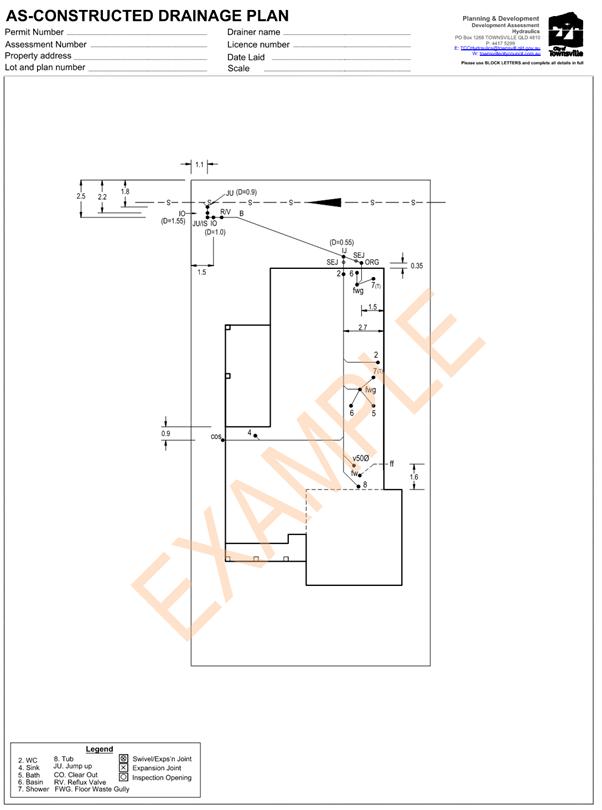All plumbing and drainage work in Queensland is regulated by state government legislative requirements and is categorised as:
All plumbing and drainage work, except unregulated work, must be performed by an appropriately licenced and endorsed person. Only permit work is approved by Council and further information on permit work, how to lodge applications and the services offered by the Hydraulics Team is provided below.
Further information on plumbing and drainage can be found in our Plumbing and Drainage Frequently Asked Questions.
Permit work is any work that is not defined by regulation as one of the other categories of work. Generally, permit work is plumbing and/or drainage work for a new building, work for an existing commercial premise that includes sanitary drainage or trade waste, and any work within a property serviced by a combine house drain.
Permit work must be assessed by Council with approval given before commencing Plumbing and drainage work. Council will inspect permit work for compliance with the code requirements and the permit conditions before the work is covered. Once the permit work has been satisfactorily completed, Council will issue a final inspection certificate for the work.
Notifiable work extends the amount of work a plumber or drainer can perform without a local government permit or mandatory inspections. Notifiable work is defined in Schedule 2 of the Plumbing and Drainage Regulation 2019. It includes most plumbing and drainage work performed in existing homes including:
For more information on notifiable work visit the Queensland Building and Construction Commission (QBCC) website.
The Hydraulics Services fee structure uses fixture numbers to calculate assessment and inspection fees, the below information will help you to understand which fixtures are counted to calculate fees for the plumbing and drainage applications:
A receptacle with necessary fittings designed for a specific purpose, the use or operation of which results in a discharge into the sanitary drainage installation.
To assist applicants in calculating fees, Townsville City Council will consider the fixtures and appliances listed on this page as chargeable fixtures. For applications involving civil works, early-stage work, or permit work that do not include fixtures, the City will calculate fees based on a meterage rate for:
| Fixtures A-M | Fixtures N-Z |
|---|---|
| Autopsy table | Pan sanitiser |
| Backflow Prevention Device (testable) | Points capped for future use |
| Bain-marie | Pump well |
| Basin | Sanitary napkin disposal unit |
| Bath (foot, baby, shower) | Shower (single/multiple) |
| Bedpan washer/steriliser | Sink |
| Bidet, bidette | Sink/bar |
| Boiling water unit (includes under bench) | Sink cleaner |
| Circular wash fountain (jug wash) | Sink laboratory |
| Clothes washing machine (commercial only) | Sink (pot or utility) |
| Coffee machine | Sink/tea |
| Combi oven | Slop hopper |
| Dental unit/chair | Sub-water meters |
| Dishwashing machine (commercial only) | Temporary building/site shed |
| Diversion valve | Trade waste pretreatment device |
| Dog Wash | Trough (ablution) |
| Drinking fountain | Trough (laundry) |
| Eyewash/safety shower | Tundish |
| Floor waste gully without fixture connected | Urinal stall, or each 600mm length of slab |
| Glass washing machine/glass cleaner | Urinal - wall hung (includes waterless) |
| Ice maker | Water closet pan (WC) |
| Inspection chamber/manhole | Wok burner (wet) |
All As-constructed plans submitted to Council’s Hydraulics Unit for plumbing or drainage Final inspections must be completed to the following minimum standards before acceptance of the plans will be considered:
Hydraulic As Constructed plans are to be drafted to the minimum drafting standard and requirements, with the addition of:
Hydraulic plans are to be drafted to the minimum drafting standards and requirements, taking note of the following:
For reference, please see example as-constructed plan below.

For more information, email TCCHydraulics@townsville.qld.gov.au or contact the Hydraulic Services team on 07 4417 5299.
Most permit applications for plumbing and drainage work use the Queensland state government Plumbing and Drainage Act 2018 forms, which can be found on the Business Queensland website.
Completed Plumbing and Drainage PDF forms can be submitted to Council by one of the following methods:
Alternatively, 'Form 1 – Permit work application for plumbing, drainage and on-site sewerage work' and 'Form 7 – Notification of Responsible Person' can be completed online:
The Plumbing and Drainage Act 2018 requires Council to approve applications within 2 business days for Fast Track applications and 10 business days for all other applications for permit work.
To find out more, please contact Council, or view the Planning fees and charges schedule.
Many plumbing and drainage works require approval before they can begin. However, not all works require approval. For more information, please visit the Queensland Building and Construction Commission (QBCC) website.
For stormwater issues, please see Council’s Urban Stormwater Drainage Factsheet.
If you believe that someone is conducting plumbing and drainage works without the required approvals, please report the concern to the Plumbing and Drainage department using the below form.
To request an as constructed drainage plan, please complete this online form. For more information, read our As Constructed Drainage Plans factsheet, or contact Council.
As well as assessment and inspection of permit work, the Hydraulics Unit at Council also offers searches of Council's electronic records of plumbing and drainage installations within a property (Plumbing and Drainage Record Request).
These services are provided at a competitive price. For more information on fees, refer to the Planning Services schedule of fees and charges.
Dial before you dig is a free referral service for information on underground pipes and cables anywhere in Australia. Using Before you Dig can prevent damage, disruption, injury, and even death.